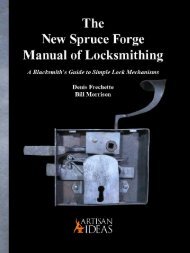Marvelous Magnetic Machines: Building Model Electric Motors from Scrap
You’re standing in front of an old card table in a driveway at a garage sale. On that table is a one-quart aluminum saucepan, a votive candle holder, pieces of some office machinery, and a wooden awards plaque. What do you see there? If you did not answer “a six-cylinder radial electromagnetic attraction motor,” then you need this book! H.P. Friedrichs (author of The Voice of the Crystal and Instruments of Amplification) returns this time to explore the principles behind the operation and construction of five simple, yet impressive, model electric motors. Aspiring mechanical model makers are often discouraged by their lack of access to machine tools, like mills, lathes, or drill presses. Friedrichs demonstrates that with some basic knowledge, an open eye, and a sharp mind, one can use commonly available (and often discarded) parts and materials to engineer one’s way around any lack of expensive machine tooling. In fact, every motor in this book was built from scrap, and can be assembled with hand tools. You’ll learn where to hunt for and find materials, and where to salvage suitable bearings. You’ll know where useful solenoids can be extracted from scrap, and how to fabricate bobbins to wind your own. You’ll learn how to time your motors, fashion a connecting rod, make a commutator from scratch, use a hall effect sensor to detect magnet position, use a transistor as a switch, and much more. Hardcover, 160 pages,177 photos and illustrations.
You’re standing in front of an old card table in a driveway at a garage sale. On that table is a one-quart aluminum saucepan, a votive candle holder, pieces of some office machinery, and a wooden awards plaque. What do you see there? If you did not answer “a six-cylinder radial electromagnetic attraction motor,” then you need this book!
H.P. Friedrichs (author of The Voice of the Crystal and Instruments of Amplification) returns this time to explore the principles behind the operation and construction of five simple, yet impressive, model electric motors.
Aspiring mechanical model makers are often discouraged by their lack of access to machine tools, like mills, lathes, or drill presses. Friedrichs demonstrates that with some basic knowledge, an open eye, and a sharp mind, one can use commonly available (and often discarded) parts and materials to engineer one’s way around any lack of expensive machine tooling. In fact, every motor in this book was built from scrap, and can be assembled with hand tools.
You’ll learn where to hunt for and find materials, and where to salvage suitable bearings. You’ll know where useful solenoids can be extracted from scrap, and how to fabricate bobbins to wind your own. You’ll learn how to time your motors, fashion a connecting rod, make a commutator from scratch, use a hall effect sensor to detect magnet position, use a transistor as a switch, and much more.
Hardcover, 160 pages,177 photos and illustrations.
You also want an ePaper? Increase the reach of your titles
YUMPU automatically turns print PDFs into web optimized ePapers that Google loves.
While the ability to record video on magnetic tape has existed since the late<br />
1950's, it was the invention of the VHS video cassette that triggered an explosion in the<br />
sale of consumer-grade video cassette recording machines. VHS remained a dominant<br />
entertainment delivery format for nearly two decades. Despite having been rendered<br />
obsolete by DVDs, Internet streaming, and other digital options, VHS tape recorders are<br />
still manufactured and sold. Obsolescence notwithstanding, the fact that a tape machine<br />
can store a two hour movie on a cassette cartridge the size of a paperback book is still an<br />
impressive feat, involving a bit of engineering magic<br />
that you have to understand to fully appreciate.<br />
Figure 5-5: The Twister's rotor is<br />
comprised of a small brass dish and<br />
three magnets of the type used to keep<br />
kitchen cabinets closed. The magnets are<br />
bolted to the rim of the dish with their<br />
south poles exposed.<br />
In recording signals on magnetic tape, there<br />
is a relationship between the rate at which data can<br />
be stored on the tape, and the rate at which the tape<br />
must be dragged across the recording heads. The<br />
more information that must be impressed upon<br />
the tape in a given span of time, the faster that<br />
tape has to move. Since television signals contain<br />
huge amounts of rapidly-changing information,<br />
the need for absurdly high tape speeds implies the<br />
consumption of thousands upon thousands of feet<br />
of tape to record even a short television program.<br />
Home video recording was made practical by some out-of-the-box thinking. Instead<br />
of simply moving the recording tape against the head, engineers worked out a way to<br />
simultaneously move the head against the tape. This trick was accomplished by fabricating<br />
the video player's heads in the form of a cylinder or drum which rotates as the tape is drawn<br />
past. The effective tape speed of this kind of system is many times the physical tape speed.<br />
All VHS tape players and recorders contain such a mechanism, and this was the source of<br />
the bearings, output shaft, and mounting hardware used in the Little Twister.<br />
Figure 5-6: A typical VCR tape head<br />
drum (top) contains many useful parts<br />
(exploded, bottom), including a shaft<br />
collar, bearings, a shaft, and various<br />
rotor and stator components.<br />
94










